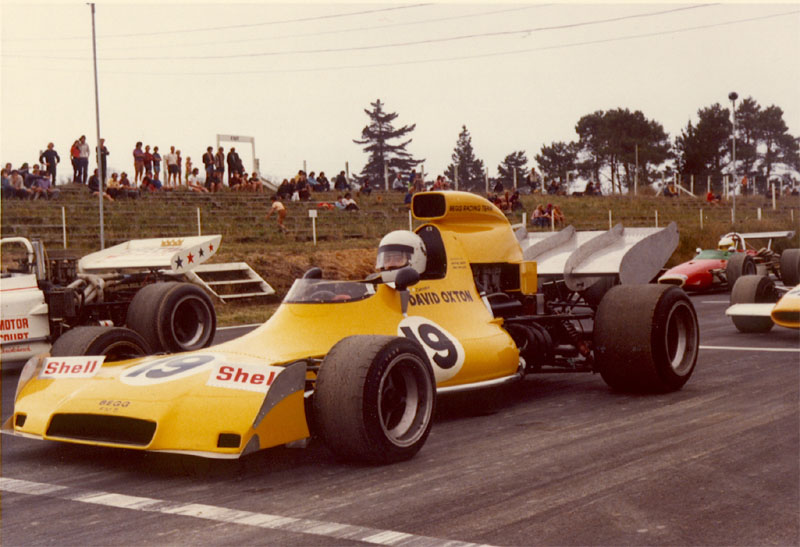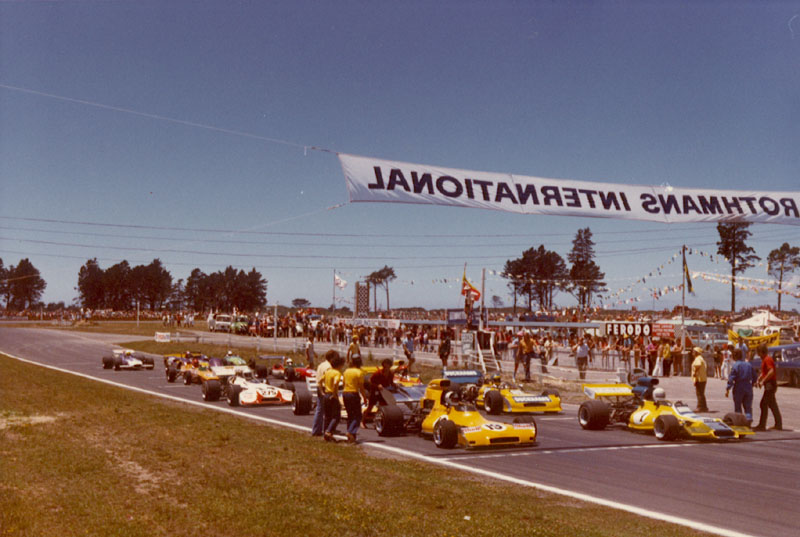-
Administrator


The FM5 was the fifteenth car to carry the Begg name. It was designed and constructed by the combined George Begg and Fred McLean partnership specifically for the Formula A/5000 regulations that were being used in many countries throughout the world by 1972. It would prove to be a highly successful car for the tiny Drummond team, one which would take them to the other side of the world.
Styling of the FM5 would be quite a radical departure from the teams previous F5000 efforts, the boxy FM2 and FM4. Much of this can be attributed to George Begg’s decision to acquire components from countryman Graham McRae, whose hugely successful McRae GM1 model was the car to beat in both the British Racing & Sports Car Club (BRSCC) European Formula 5000 series, the American L&M series, and the Tasman Series, throughout 1971 and 1972.
The McRae GM1 featured bulging rounded fuel-cells mounted in a very low position either side of the driver, which largely dictated its body shape. Following the 1972 Tasman Series, in which McRae was crowned champion, Begg purchased several items for the upcoming FM5, including fuel-cells, wheels, suspension, and uprights. In addition, he also purchased the Benoit Morand built fuel-injected Chevrolet used by McRae to win the Sandown Tasman Series race. During the race, the engine overheated quite severely, after losing much of its coolant, and McRae offered it to Begg at a discounted price, due to him not wanting to retain the motor, for fear of damage.
Much like the GM1, the shape of the new FM5 was largely influenced by its fuel-cells. As Begg himself explained in his book When The Engine Roars, ‘Fred and I spent hours discussing how the FM5 should look, although the rounded fuel-cells I had bought from Graham virtually dictated the shape. They were the newer bulging type which gave the car a similarly built appearance. That meant our car would have some exotic looking shapes over its body with curves going in several directions. Some extensive panel-beating would be required and after Fred and I had designed what we wanted, we gave the work to a young Invercargill panel beater to carry out’.
Indeed, this would be a very curvaceous, and quite attractive looking race car. Although the fuel-cells offered a similar central body shape to the GM1, the Begg would feature quite a different looking nose, influenced by a visit to an L&M race at Riverside Raceway, California, in 1972, where the new Derek Bennett designed Chevron B24 was competing. Begg was most impressed with this car. With its quarter-round fixed blunt nose, which differed to the adjustable winglets most manufacturers opted for, McRae included, Begg admired the Chevrons simple, clean shape, which also included very flat cockpit sides. This, Begg concluded, was a superior design to that which his team had already committed to, and this was confirmed to him when Chevron driver Brian Redmond won the race. The FM5 featured a similar style nose to that of the Chevron, and sprouted fences and splitters at each end.

Fred McLean set to work constructing the aluminium monocoque tub, to which the Chevy motor would be fixed as a stressed-member, to help add rigidity and centralise most of the cars weight. The tub, without fuel tanks attached, weighed in at 32 kilograms, and was rigid thanks to the technique of sandwiching a 1 inch thick polystyrene slab between two aluminium sheets with glue to form the bulkhead. McLaren front wheels were used, along with Lockheed brakes. The McRae supplied Chevy motor was torn down and found to have suffered little apparent damage from its Sandown misadventure, and was rebuilt with new rings and bearings.
McLean proved highly adaptive in designing the FM5, typical of many New Zealand race car builders who didn’t enjoy the luxury of simply purchasing off the shelf parts, as those in the Northern hemisphere did. Other than the parts Begg was able to acquire from McRae, and Phil Kerr at McLaren, virtually everything was hand made either by McLean, or any number of talented fabricators in and around the Invercargill area.
Up to and including the FM5, most Begg race cars were painted yellow. And the swoopy new machine from Drummond was no exception when it made its race debut at Round 2 of the New Zealand Gold Star, held at Pukekohe on 12 November, 1972. George Begg had re-signed the talented youngster David Oxton, who’d won the 1972 New Zealand Gold Star in the Begg FM4, to drive the new car, which he promptly parked on pole, before going on to win by just over 1 minute from Garry Pederson in Oxton’s old FM4.
Oxton also won Round 3 at Ruapuna, before being ousted by Pederson in Round 4 at Levin, after a race-long battle between the two Begg combatants. The final round, at Bay Park, was to be contested over two heats, and joining the mix was Graham McRae, getting in a little action on Kiwi soil before the 1973 Tasman Series began in earnest one week later. McRae was fastest in qualifying, and took off to lead Heat 1 before retiring with a slipping clutch, handing victory to Pedersen from Oxton. McRae was a non-starter for Heat 2, and Oxton controlled the race from start to finish, winning his second Gold Star title in succession.
 Posting Permissions
Posting Permissions
- You may not post new threads
- You may not post replies
- You may not post attachments
- You may not edit your posts
-
Forum Rules






 Reply With Quote
Reply With Quote